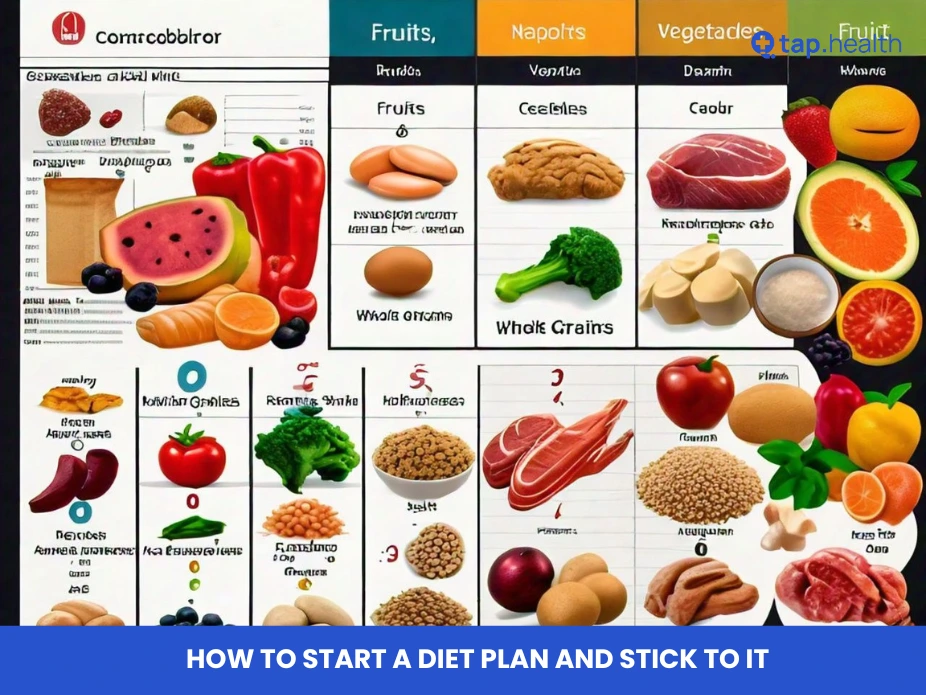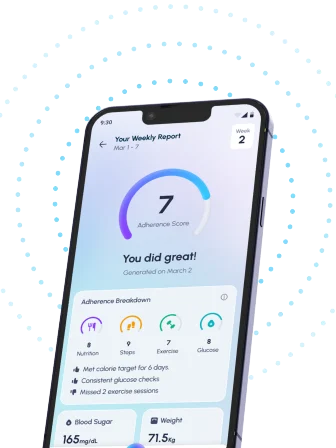Starting a diet plan can feel overwhelming. Whether you’re looking to lose weight, build muscle, or simply live a healthier lifestyle, it’s important to know how to begin and, most importantly, how to stick to it. In this blog, we’ll walk you through how to start a diet plan and maintain it over the long term. From creating a simple, achievable plan to staying motivated, we’ve got you covered with easy-to-follow strategies that anyone can adopt.
Why Diet Plans Matter
A diet plan is not just about eating less or avoiding certain foods. It’s about fueling your body with the nutrients it needs to stay healthy, improve energy levels, and reach your personal health goals. Whether your aim is to lose weight, increase energy, or reduce the risk of chronic diseases, a diet plan can help you stay on track.
But starting a diet plan isn’t always easy. People often fall off track because they set unrealistic goals, forget to make adjustments as they go, or struggle with motivation. However, by understanding the core principles of a diet plan and following practical steps, sticking to a diet becomes a lot more achievable.
How to Start a Diet Plan
1. Set Realistic Goals
The first step in any diet plan is setting achievable, realistic goals. If you aim to lose weight, for instance, make sure you choose a target that is both safe and attainable. Experts suggest aiming for a weight loss of 1 to 2 pounds per week. This is a healthy and sustainable rate that won’t leave you feeling deprived or frustrated.
When setting goals, consider these factors:
- Long-term vision: What do you want to achieve in the next 6 months to a year? This could include weight loss, muscle gain, or better health markers like cholesterol or blood pressure.
- Short-term milestones: Break your long-term goals into smaller steps. For example, aim to lose 5 pounds in the first month, then reassess.
- Non-scale goals: Health improvements such as feeling more energized, sleeping better, or reducing sugar cravings are just as important as seeing the number on the scale drop.
2. Create a Balanced Meal Plan
A successful diet plan isn’t just about cutting out foods; it’s about making better choices that nourish your body. A balanced diet plan should include:
- Proteins: Essential for muscle growth and repair. Good sources include lean meats, fish, eggs, tofu, and legumes.
- Carbohydrates: Your body’s primary energy source. Opt for whole grains like brown rice, oats, and quinoa, and limit refined carbs.
- Fats: Healthy fats help with cell function and hormone regulation. Include sources like avocado, olive oil, and nuts.
- Fiber: Helps with digestion and keeps you feeling full. Vegetables, fruits, and whole grains are excellent sources.
- Hydration: Drink plenty of water. It’s essential for digestion, metabolism, and general health.
A balanced meal plan should provide all the necessary nutrients without leaving you feeling deprived.
3. Find a Diet That Fits Your Lifestyle
The key to sticking with a diet plan is choosing one that suits your personal preferences and lifestyle. Here are a few popular options:
- Mediterranean Diet: Focuses on whole grains, healthy fats (like olive oil), lean proteins (like fish), and plenty of fruits and vegetables. It’s known for its heart health benefits.
- DASH Diet: Designed to lower blood pressure, this diet emphasizes fruits, vegetables, whole grains, and low-fat dairy products, while limiting sodium.
- Plant-Based Diet: Focuses on plant-derived foods, with little to no animal products. It’s rich in fiber, antioxidants, and healthy fats.
- Low-Carb Diet: Focuses on reducing carbs and increasing protein and fat intake. Ideal for those aiming for weight loss or better blood sugar control.
Choose a diet plan that aligns with your tastes and goals. If you don’t like certain foods, no diet will work in the long run.
4. Start Slow and Make Gradual Changes
When it comes to starting a diet plan, slow and steady wins the race. Making drastic changes to your eating habits overnight is a recipe for failure. Instead, start by making small changes:
- Swap sugary snacks with healthier alternatives like fruits or nuts.
- Gradually reduce your intake of processed foods and focus on whole, unprocessed options.
- Try meal prepping on weekends to avoid impulsive, unhealthy food choices during the week.
These small adjustments will help you gradually shift your eating habits without feeling overwhelmed.
5. Track Your Progress
Tracking your progress is essential to staying on course. Use a journal or a mobile app to log your meals, water intake, and exercise. Keeping track of what you’re eating can help you stay mindful of your diet, identify areas of improvement, and celebrate your wins, no matter how small.
You can also track non-scale victories, such as feeling more energetic or noticing that your clothes fit differently. These reminders will help keep you motivated when the scale doesn’t reflect your hard work.
Real-Life Scenarios
Scenario 1: Lisa’s Weight Loss Journey
Lisa, a 34-year-old woman, struggled with yo-yo dieting for years. She wanted to lose weight but never stuck with a plan. One day, Lisa decided to stop focusing on quick fixes and instead aimed to make small, sustainable changes. She started by swapping her afternoon soda with sparkling water, then replaced her usual fast food lunch with a homemade salad. Over time, she added more exercise and reduced her carb intake. Six months later, Lisa had lost 20 pounds, felt more energetic, and had developed a positive relationship with food.
Scenario 2: Mark’s Cholesterol Control Plan
Mark, 50, had high cholesterol and wanted to avoid medication. His doctor advised him to adopt a heart-healthy diet. Mark started by cutting out processed meats and focusing on increasing his fiber intake with vegetables and whole grains. He also incorporated more healthy fats, like those from avocado and olive oil. After three months of following this plan, his cholesterol levels improved, and he was able to avoid medication altogether.
Expert Contributions
Dr. Robert Johnson, a renowned nutritionist, emphasizes the importance of consistency when starting a diet. “The key to sticking with any diet plan is consistency. Rather than looking for shortcuts or quick fixes, it’s crucial to adopt habits that you can maintain for the long term. Gradual changes are more effective than drastic ones, and they lead to lasting results.”
Dr. Sarah Miller, a weight-loss expert, shares, “Diet plans should not feel like punishment. You should enjoy what you eat and feel satisfied. Don’t focus too much on restriction. Instead, focus on what you can add to your meals to make them more nutritious.”
James O’Neill, a fitness expert, adds, “Exercise is a key component in any diet plan. While diet plays a large role in weight loss, regular physical activity boosts metabolism, helps with weight maintenance, and enhances overall health.”
Recommendations Grounded in Proven Research and Facts
Starting a diet plan and sticking to it is supported by proven strategies and scientific research:
- Smaller, Frequent Meals: Research suggests that eating smaller, balanced meals throughout the day helps maintain steady blood sugar levels and control hunger. Mayo Clinic
- Mindful Eating: Studies show that practicing mindful eating—paying full attention to what, when, and how you eat—can lead to healthier choices and better digestion. Harvard Health
- Behavioral Support: A study published in the Journal of Obesity found that people who track their food and exercise are more likely to succeed in losing weight and keeping it off. National Institute of Diabetes and Digestive and Kidney Diseases
- Exercise: Regular physical activity has been shown to improve weight loss outcomes and health markers, like blood pressure and cholesterol. Cleveland Clinic
Factual and Reliable Information
Starting and sticking to a diet plan is not about perfection, but about building long-term habits that promote good health. Here are some science-backed tips to help you succeed:
- Avoid Extreme Restrictions: Extreme diets often fail in the long run because they aren’t sustainable. Aim for a balanced approach that includes all food groups.
- Exercise Regularly: Aim for at least 150 minutes of moderate exercise per week, or 75 minutes of vigorous activity, plus muscle-strengthening exercises twice a week.
- Get Enough Sleep: Research shows that poor sleep can interfere with hunger hormones, leading to overeating. Aim for 7-9 hours of sleep each night.
- Stay Hydrated: Drink water throughout the day to stay hydrated, which can also help curb unnecessary hunger.
Frequently Asked Questions (FAQ) on how to start a diet plan and stick to it
1. How do I stay motivated on a diet?
Find a support system, track your progress, and set realistic goals. Celebrate small victories to stay motivated.
2. How can I make sure my diet plan is effective?
Focus on balanced, nutrient-dense foods, and make sure your plan fits your lifestyle. Regular exercise and hydration also play crucial roles.
3. Should I cut out carbs entirely?
No, you don’t need to cut out carbs completely. Opt for complex carbs like whole grains, fruits, and vegetables, which provide essential nutrients.
4. How do I deal with cravings?
Cravings can be managed by staying hydrated, eating balanced meals, and occasionally allowing yourself small indulgences in moderation.
5. How quickly will I see results?
Results vary depending on the individual and their goals. However, healthy weight loss typically occurs at a rate of 1-2 pounds per week.
6. Can I eat out while following a diet plan?
Yes! Look for healthier options on the menu, like grilled meats, salads, or whole grain sides. Many restaurants also offer lighter versions of their dishes.
7. What should I do if I fall off track?
Don’t give up! Get back on track by focusing on your goals and making small adjustments to your diet. It’s okay to have setbacks, but the important thing is to keep moving forward.




